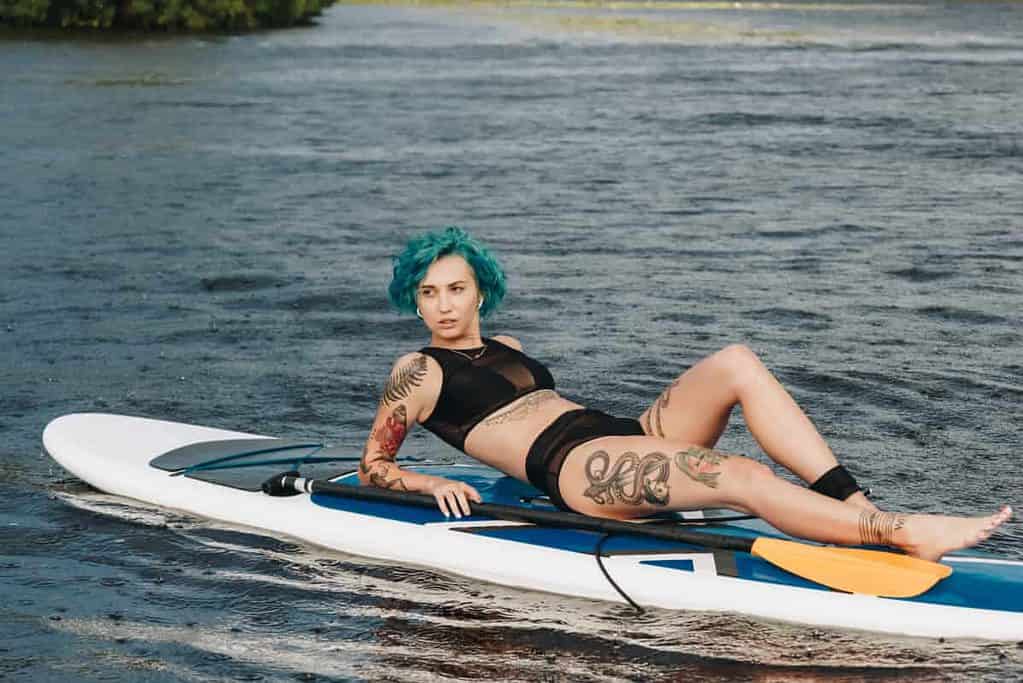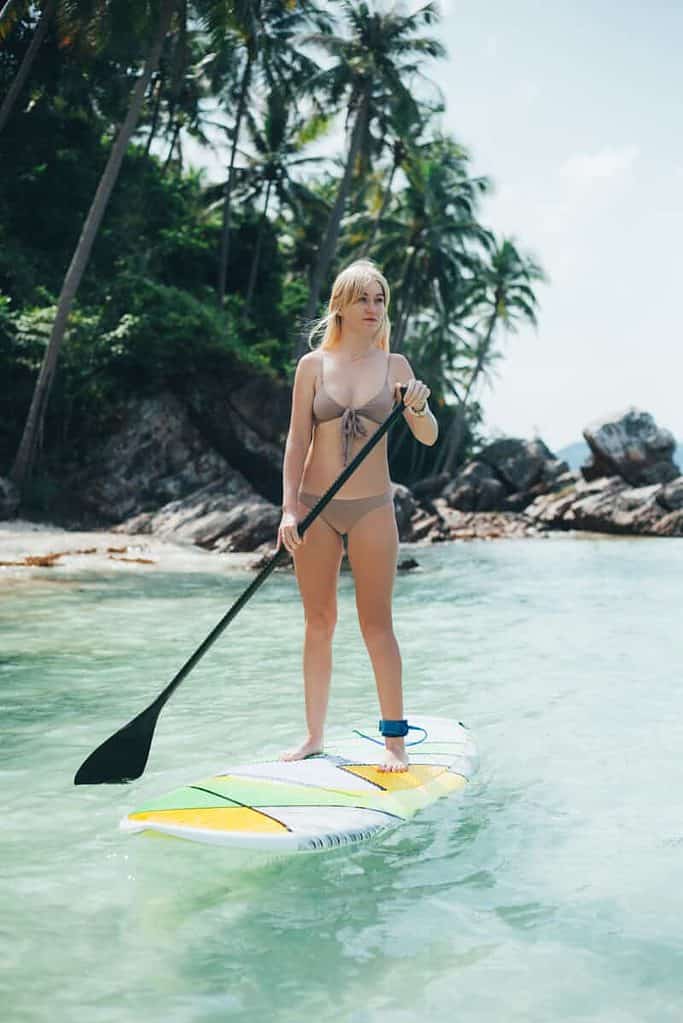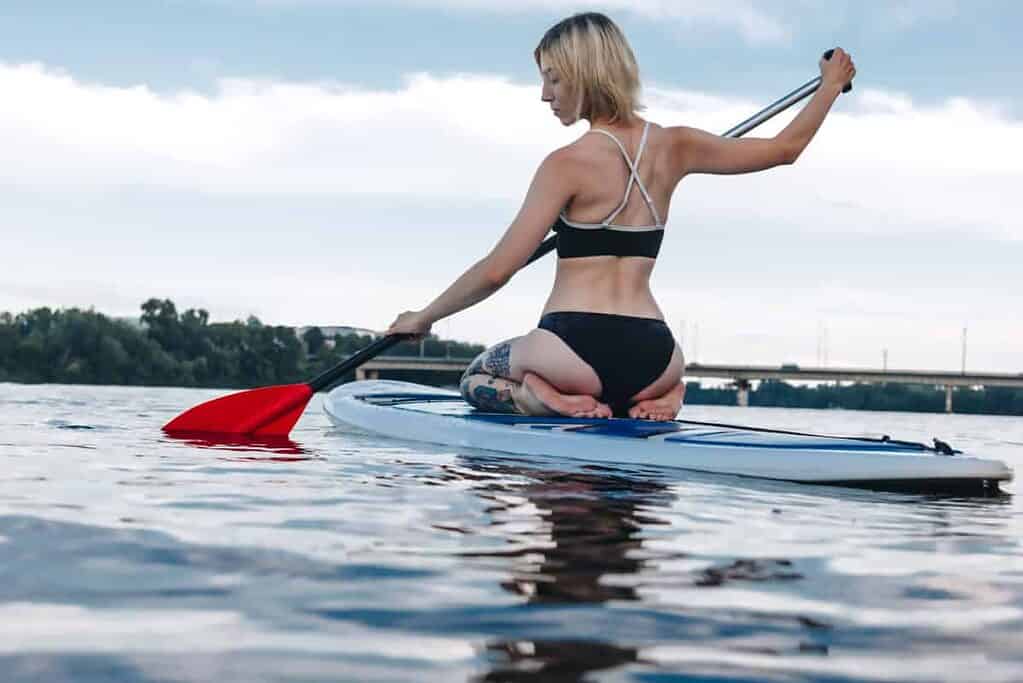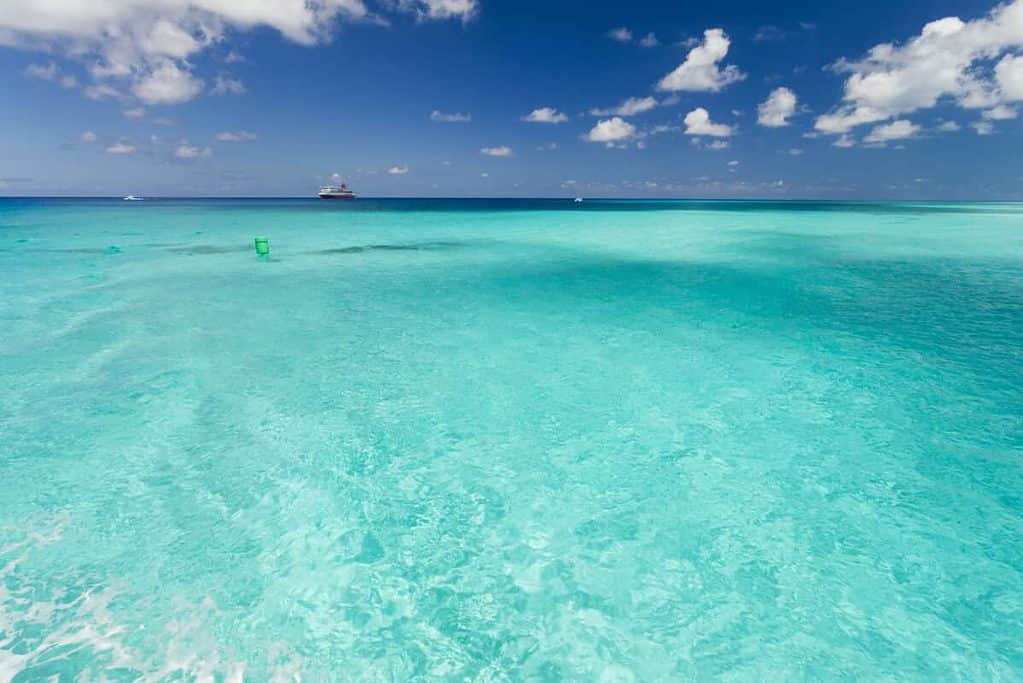
Learn popular Canoeing, kayaking terms that you need to know before hitting the water! Canoe paddles have only one blade, while Kayak paddles have a blade at both ends of the shaft.
Air brace – An ineffectual brace in which the paddle blade is waggled above the water until the boat capsizes.
Attain – Paddling upstream against a current.
Back Stroke – The technique used for moving backward by pushing instead of pulling the paddle through the water. The shaft of the paddle should be almost parallel to the water surface with the grip outside of the gunwale. Your fingers should be down toward the surface of the water. Your shaft hand should be on top of the shaft.
Baja sleigh ride – When a kayak fisherman hooks into a fish big enough to pull him and his kayak in circles; also Texas sleigh ride, Gulf Coast sleigh ride
Bearing – The direction in which you wish to travel
Beater – A paddler who lacks skill or experience kayaking.
Beatdown – What ensues after you miss your boof and drop into a hole.
Bent Shaft Paddle – An ergonomically designed paddle that is bent to allow the paddler’s wrists to maintain a neutral position.
Blade – The wide part at the end of a paddle. This is the portion of the paddle that is pulled through the water to move the boat forward.
Bony – also known as scratchy. Shallow water that scrapes up your boat. A run or rapid requiring lots of maneuvering because of the abundance of obstacles, mostly rocks.
Boof – A boof is a maneuver where a kayaker uses his paddle, rock or water feature to lift the bow of the kayak over a drop, usually performed to avoid a piton or getting stuck in a hydraulic. To propel a kayak over a rock or ledge.
Booties – Neoprene socks or boots used to keep your feet warm in cold weather
Brace or Bracing – A paddling stroke used to keep the boat from capsizing. Any paddle stroke that helps the paddler maintain his/her balance. The high and low brace are the most common bracing strokes but forward and turning strokes also work as bracing strokes in many situations.
Broach – Occurs when a canoe or kayak becomes caught up against an obstacle and turned sideways to the current. Can result in severe damage as the current’s force warps the boat around the obstruction.
Bulkheads – The walls which create sealed watertight compartments in the bow and stern of a kayak and provide structural support and buoyancy.
Capsize – to cause to overturn. capsize a canoe – Sometimes vessels that capsize can be righted, like a canoe, and other times they sink to the bottom of the sea. The origin of capsize is uncertain, though it may be related to the Spanish word capuzar, “sink by the head.” “Don’t rock the boat or it will capsize!”
Carnage – General term for a mishap, as in a boat flipping or someone falling out. A jovial term to describe what happens after you lean upstream in a broach.
Carp – An unsuccessful roll in which the kayaker doesn’t make it all the way to the surface, but manages to catch a quick breath.
CFS – Cubic feet per second, referring to the volume of water flow at a certain point on the river.
Chine – The angle where the sides of the boat meet the bottom.
Class I Rapid – The least dangerous and easiest type of whitewater to negotiate in your kayak.
Class II Rapid – Slightly more waves and turbulence than what you will find in a Class I rapid, but still very easy to negotiate with very little danger.
Cockpit – The opening in the deck of a kayak where the paddler is seated.
Creeking – Sometimes called steep creeking or treetop boating or creekboating is a branch of canoeing and kayaking that involves descending very steep low-volume whitewater. It is usually performed in specialized canoes and kayaks specifically designed to withstand the extreme whitewater environment in which the activity occurs. In addition, the canoes and kayaks give the paddler improved performance and maneuverability needed to avoid river obstacles.
Downstream – The direction that the current is moving in a river
Draw stroke – Draw strokes are used to move your boat sideways. This stroke is useful if you need to pull close to a dock or another boat: Rotate your paddle blade so it’s horizontal. Reach out with the tip of the blade to touch the water about two feet away, directly on the side of your boat. A stroke performed by placing the paddle out in the water parallel to the boat and pulling the blade towards the hull.
Drop – A short, well-defined rapid, or section of a rapid. Named for the abrupt ‘drop’ in elevation between the top and bottom.
Drybag – A waterproof bag used for gear storage. A dry bag, as its name implies, keeps things dry. When your chosen activity is on the water, that’s important! Dry bags come in different sizes, materials and styles.
Drytop – A jacket designed to keep your upper body completely dry while paddling.

Eddy – A place in the river, often behind an obstruction or inside a sharp turn, where the water reverses and flows upstream. General patterns of ocean flow are called currents. Sometimes theses currents can pinch off sections and create circular currents of water called an eddy. You may have seen an eddy if you’ve ever gone canoeing and you see a small whirlpool of water while you paddle through the water.
Eddyline – The eddy line is the swirly line where the current flowing upstream inside the eddy meets the main current which is flowing downstream. Eddy lines get easier to recognize the more you study them and the more you practice crossing them while practicing ferries, eddy turns and peel outs.
Feather angle – Kayak paddle blades are positioned on different planes on the shaft, at an angle relative to one another typically 30-60 degrees.
Feathering – What is paddle feathering?
Feathering a kayak paddle simply means you adjust the ferrule on the shaft so the blades are at an angle to each other rather than straight.
Ferrule – What is ferrule?
The ferrule is where the two pieces of the kayak paddle come together in the middle of the shaft.
Ferry – Angling the boat to move sideways or upstream against a current, Maneuvering across the current rather than with it.
Footpegs (also known as foot braces)- Adjustable structures located within a kayak’s cockpit which provide support and increased leverage for the paddler.
Forward Stroke – The most basic stroke used to move a kayak in a forward direction.
Groover – The latrine on a multi-day river trip. In river rafting terminology, a “groover” is a rocket box which serves as a latrine.
Gunwales – The wood, aluminum or vinyl pieces running from bow to stern along the top of the hull.
Hatch – A storage compartment in the body of the kayak which can be reached from the cockpit. Keeps items dry even in rough water when the hatch cover is secured.
Heading – The direction in which your kayak’s bow is pointing.
Hip snap – Throwing the hips (and knees) in motion to roll a kayak. The hip-flick, (sometimes called the hip-snap), is a technique used in kayaking to rotate the boat around its longest axis. It is fundamental to all kayaking techniques that return the boat to upright after a capsize, such as the eskimo roll and eskimo rescue.
Hole (also hydraulic, keeper) – “Holes” are formed when moving water pours over a submerged object, causing the surface water to flow back upstream toward the object.
Huck – The act of running a waterfall.
Hull – The bottom part of the kayak that sits in the water.
J-Cradle – A “J”-shaped rack accessory that allows you to easily and securely tie down a kayak on top of your car.
Kayak – A kayak is a low-to-the-water, canoe-like boat in which the paddler sits facing forward, legs in front, using a double-bladed paddle to pull front-to-back on one side and then the other in rotation. Most kayaks have closed decks, although sit-on-top and inflatable kayaks are growing in popularity as well.
Keel – A raised ridge that runs along the bottom of a boat from end to end along the centerline to help tracking and add stability.
Lee – An area sheltered from wind and weather.
Limbo log – A fallen log spanning the river with enough room to scrunch down in the boat and limbo beneath.

OC-1 – What is an OC1 Canoe?
An open canoe for one person. – Solo canoe or kayak
OC-2 – Open Canoe for Two, tandem canoes or kayaks
Oil canning – Oil canning is a word used to describe the indentations on the hull of your kayak. These indentations may occur if your yak is stowed on the bottom of its hull or is strapped down too firmly on a roof rack. It describes the floor of a poorly constructed or flat-bottomed canoe or kayak when it bounces up and down in turbulent waters.
Open Water – A large body of water (such as an ocean or Great Lake) that offers no protection from the wind.
Paddle – The means of propulsion and maneuvering for a canoe or kayak. Canoe paddles have only one blade, while paddles for kayaks have a blade at both ends of the shaft.
PFD – Stands for Personal Flotation Device, otherwise known as a lifejacket. No matter how strong a swimmer you are, you should always wear a Coast-Guard approved PFD when kayaking – especially in whitewater.
Pogies – Mittens that attach to the paddle shaft for cold weather paddling. pogie (plural pogies) (rowing, kayaking) A protective hand covering attached to the oars or paddles while rowing, canoeing or kayaking. They insulate the hands from wind and cold while allowing the bare hands inside to contact the paddle shaft or oar and maintain grip and feel.
Portage – The act of carrying your kayak over land instead of riding in it on the water. It is sometimes necessary to carry a kayak in order to get from one waterway to another or to avoid a particularly dangerous area of rapids.
Poling – Using a long wood or aluminum pole to push the boat upriver from a standing position. Also known as going up a creek without a paddle.
Rapid – A section of river with a faster current and intensified turbulence caused by an increase in the incline or gradient of the river.
Reading Water – The ability to find the safest route through rough whitewater.
River-right – The right-hand side of the river when facing downstream. The opposite of river-left. As you face downstream, the banks of the river are referred to as “River Right” and “River Left”.
Rocker – Longitudinal curvature in the bow and stern of a boat along the bottom of the hull. Rocker refers to the amount of curvature in the bottom of the hull along its length from bow to stern. Rockered. A rockered paddlecraft is easier to turn and maneuver but harder to paddle in a straight line
Roll – Recovering from a capsize while remaining in the boat, requiring a coordinated hip snap and paddle stroke to bring the boat back upright. Roll (or Eskimo Roll) – A maneuver to right a capsized kayak without exiting the cockpit.
Rudder – A steering device located at the stern of some kayaks. It may be operated either by foot pedals or by pulling rope lines on the deck of the kayak.

Sculling Draw – A figure eight stroke used to pull the kayak sideways.
Shaft – The pole that holds the blades of a kayak paddle.
Shortie – A paddling jacket with short sleeves.
Sit-On-Top (SOT) – An open kayak without a cockpit.
Skeg – An adjustable steering fin which is used to help keep some sea kayaks on a straight track. Similar to a rudder.
Spray Skirt – A waterproof “skirt” that is worn around the waist of the kayaker and attached to the rim of the cockpit. Keeps the cockpit dry in rough water and offers extra protection from the sun, rain, and wind
Stern – The back end of a kayak or any other type of boat.
Strainer – A tree or branch that allows water to pass through, but creates a trap for kayaks and canoes.
Sweep stroke – Used to turn the boat opposite the stroke side by pulling the blade in an outreached arc from bow to stern.
Swim – Exiting your craft into the water after a capsize or to get out into the water to cool off
Swim beer – The traditional beverage purchased for someone who helps to rescue you when you go for an unintentional swim.
Tandem – A two-person canoe or kayak. A kayak with two cockpits which allows two people to paddle at the same time. This is a slightly longer vessel which is ideal for couples or an adult and child
Thwart – A cross-brace between the sides of a canoe or the tubes of a raft.
Trip leader – A god-like creature who has volunteered to shoulder the burden of responsibility, make arrangements, coordinate meeting times and organize the shuttle. In homage to these great souls, trip members typically proffer an unending supply of alcohol and undying respect.
Tracking – The ability of a boat to hold and maintain a straight course due to the design of its hull.
Tricky-Woo – This is a complicated maneuver done by competitive freestyle kayakers that involves three consecutive 180-degree horizontal angle rotations using only one paddle blade.
Tumblehome – The cross-section shape of a hull that decreases in width from the waterline to the gunwales. Tumblehome is when the gunnel width is less than the overall width of the canoe. You can see that by looking down the side, and see that the widest point is just below the gunnel, and it actually tucks in towards the gunnel, towards the top.
Upstream – The opposite direction from the flow of a river’s current.
Water Sandals – Waterproof footwear with a non-slip sole made especially for water sports such as kayaking.
Wet exit – Going for an impromptu swim. The act of swimming out of your kayak generally unexpectedly rather than climbing out of it which would be a dry exit.
Wetsuit – A form-fitting neoprene suit that helps prevent hypothermia by trapping a thin layer of water between the neoprene and your skin.
Whitewater – Water that appears white when it mixes with air. Whitewater occurs when a strong river current flows over rocks or other obstacles, or when the incline of a river increases and creates a more rapid and turbulent flow.
Yoke – The yoke of a canoe is the cross beam in the center of the canoe that connects the starboard and aft sides. It usually has a curved indentation in the center of it that ergonomically fits over the neck of a canoeist.
Z-drag – The 60-second Z-drag is a simple and efficient rope rescue system to help you and your paddling pals out in a sticky situation. Secure a sling of rope or webbing around the anchor point. A Z-Drag or Z-Rig is an arrangement of lines and pulleys, effectively forming a block and tackle, that is commonly used in rescue situations.

